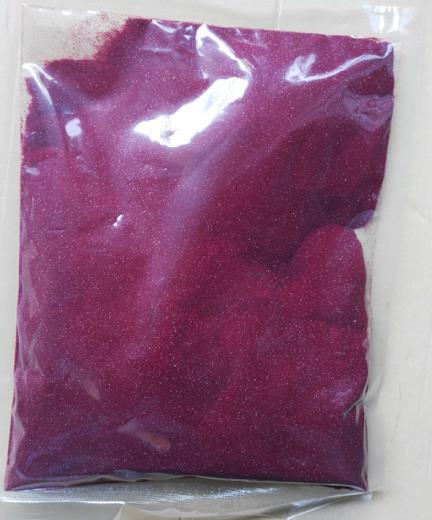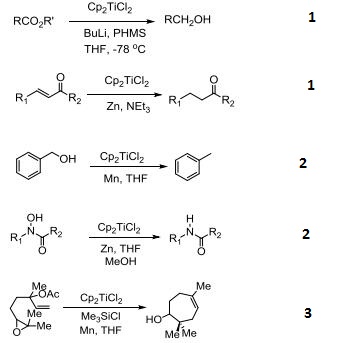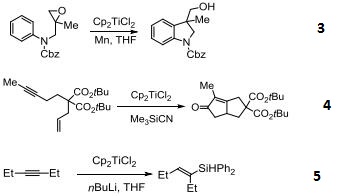|
ChemicalBook Optimization Suppliers |
|
| 融点 | 260-280 °C (dec.)(lit.) | | 沸点 | 355.52°C (estimate) | | 比重(密度) | 1.6 g/mL at 25 °C(lit.) | | 蒸気圧 | 0.002Pa at 25℃ | | 貯蔵温度 | Inert atmosphere,Room Temperature | | 溶解性 | slightly soluble in H2O, benzene; soluble in chloroform,ethanol, toluene | | 外見 | crystal | | 色 | red | | 比重 | 1.6 | | 水溶解度 | slow decomposition | | Sensitive | Air & Moisture Sensitive | | Hydrolytic Sensitivity | 4: no reaction with water under neutral conditions | | Merck | 14,9482 | | 安定性: | Stable. Incompatible with strong oxidizing agents. Decomposes in water. Moisture sensitive. | | LogP | -1.35 at 20℃ | | CAS データベース | 1271-19-8(CAS DataBase Reference) | | NISTの化学物質情報 | Titanocene dichloride(1271-19-8) | | EPAの化学物質情報 | Titanocene dichloride (1271-19-8) |
| | チタノセンジクロリド Usage And Synthesis |
| 外観 | 赤色~赤褐色, 結晶~粉末 | | 溶解性 | クロロホルムに溶け、水で分解する。 | | 説明 | Titanocene dichloride is an organotitanium compound with the chemical formula (η5-C5H5)2TiCl2, often written as Cp2TiCl2, which is a common reagent in organometallic chemistry and organic synthesis. Cp2TiCl2 does not form a "sandwich" structure like ferrocene, but a tetrahedral structure due to its four ligands around a metal center. Because of its anti-tumor activity, it has been used in clinical trials as a chemotherapeutic agent. | | 化学的特性 | Titanocene dichloride is a reddish-orange crystalline solid. Moderately soluble in toluene, chloroform, alcohol, and other hydroxylic solvents; sparingly soluble in water, petroleum ether, benzene, ether, carbon disulfide, and carbon tetrachloride. Stable in dry air, slowly hydrolyzed in moist air. Titanocene dichloride is irritating to the skin and mucous membranes. | | 使用 | Titanocene dichloride is used as an experimental cancer chemotherapeutic agent. It is used as a research chemical, as a catalyst in Ziegler–Natta polymerization reactions, and as an implant material in orthopedics, oral surgery, and neurosurgery.This metallocene is a common reagent in organometallic and organic synthesis. Titanocene dichloride is used to prepare titanocene pentasulfide. Used as an anticancer drug. | | 製造方法 | Cp2TiCl2 continues to be prepared similarly to its original synthesis by Wilkinson and Birmingham:
2 NaC5H5 + TiCl4 → (C5H5)2TiCl2 + 2 NaCl
The reaction is conducted in THF. Work-up entails extraction into chloroform/hydrogen chloride and recrystallization from toluene. In the original literature, the structure was poorly understood. Each of the two Cp rings are attached to Ti(IV) through all five carbon atoms. In organometallic chemical jargon, this bonding is referred to as η5 (see hapticity). | | 調製方法 | Titanocene dichloride is produced by the reaction of titanium
tetrachloride with cyclopentadienyl sodium. | | 反応性 |
-
Precatalyst for reduction of esters and |á,|?-unsaturated ketones.
-
Catalyzes reductive deoxygenation of alcohols and hydroxylamines.
-
Catalyst for the radical cyclization of epoxides.
-
Reagent for the conversion of enynes to bicyclic cyclopentenones.
-
Catalyzes silylation of alkenes and alkynes.

 | | 一般的な説明 | Titanocene dichloride appears as red to red-orange crystals. (NTP, 1992) | | 空気と水の反応 | Stable in dry air. Decomposes in moist air and in water to form HCl . | | 反応プロフィール | Titanocene dichloride is incompatible with strong oxidizers. Titanocene dichloride may decompose on exposure to water. . | | 危険性 | Toxic by inhalation, irritant to skin and
mucous membranes. | | 火災危険 | Flash point data for Titanocene dichloride are not available; however, Titanocene dichloride is probably combustible. | | 燃焼性と爆発性 | Non flammable | | 安全性プロファイル | Poison by intravenous
and intraperitoneal routes. Questionable
carcinogen with experimental neoplastigenic,
tumorigenic, and teratogenic data. Mutation
data reported. See also TITANIUM
COMPOUNDS. When heated to
decomposition it emits toxic fumes of Cl- | | 発がん性 | Based on the results of 2 year
gavage studies, the National Toxicology Program determined
that there was equivocal evidence of the carcinogenic activity
of titanocene dichloride in male and female rats based on a
marginal increase in the incidence of forestomach squamous
cell effects. | | 純化方法 | It forms bright red crystals from toluene or xylene/CHCl3 (1:1) and sublimes at 190o/2mm. It is moderately soluble in EtOH and insoluble in Et2O, *C6H6, CS2, CCl4, pet ether and H2O. The crystalline dipicrate explodes on melting at 139-140o. [Wilkinson et al. J Am Chem Soc 75 1011 1953, IR: Wilkinson & Birmingham J Am Chem Soc 76 4281 1954, NMR and X-ray: Glivicky & McCowan Can J Chem 51 2609 1973, Clearfield et al. J Am Chem Soc 53 1622 1975, Beilstein 16 IV 1769.] | | Clinical claims and research | Titanocene dichloride, [Ti(Z5 -C5H5)2Cl2], was the first organometallic transition metal compound to be investigated clinically as an anticancer agent. It contains a cis-dichloride motif as cisplatin and was selected from several early transition metal cyclopentadienyl complexes as the best candidate for further development. The chemistry of the hard Ti(IV) ion is different from that of Pt(II): for example, cisplatin binds preferentially to the N7 of guanine in DNA, whereas titanocene dichloride exhibits higher affinity for the phosphate backbone. [Ti(Z5 -C5H5)2Cl2] hydrolyzes quickly in water, yielding a solvated Ti(IV) ion with high affinity for transferrin. As for Ga(III), selective transport of titanium ions via the transferrin route appears plausible. In vitro, titanocene dichloride is active in cisplatin-resistant cancer cells. It entered clinical trials in 1993, revealing nephrotoxicity as dose-limiting side effect. In Phase II studies as singleagent therapy no advantage over other treatment regimens was observed, and the trials were thus abandoned. |
|